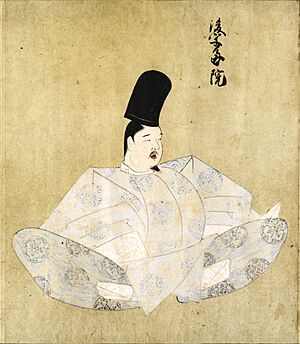Emperor Go-Uda facts for kids
Quick facts for kids Emperor Go-Uda後宇多天皇 |
|||||
|---|---|---|---|---|---|
 |
|||||
| Emperor of Japan | |||||
| Reign | 6 March 1274 – 27 November 1287 | ||||
| Coronation | 4 May 1274 | ||||
| Predecessor | Kameyama | ||||
| Successor | Fushimi | ||||
| Shōgun | Prince Koreyasu | ||||
| Born | 17 December 1267 Mansion of Tsuchimikado-dono (土御門殿), Heian kyō |
||||
| Died | 16 July 1324 (aged 56) Buddhist temple of Daikaku-ji (大覚寺), Heian kyō |
||||
| Burial | Rengebu-ji no Misasagi (蓮華峯寺陵) (Kyoto) | ||||
| Spouse |
Reishi
(m. 1285; died 1307) |
||||
| Issue Among others... |
|
||||
|
|||||
| House | Yamato | ||||
| Father | Emperor Kameyama | ||||
| Mother | Fujiwara no Saneko | ||||
| Signature |  |
||||
Emperor Go-Uda (後宇多天皇, Go-Uda-tennō, 17 December 1267 – 16 July 1324) was the 91st emperor of Japan. He ruled from 1274 to 1287.
His name, Go-Uda, means "Later Emperor Uda." This is because he was named after an earlier emperor, Emperor Uda, who lived in the 9th century. The word go- (後) means "later" or "second."
Contents
Family Life
Before he became emperor, his personal name was Yohito (世仁). He was the second son of Emperor Kameyama. His family belonged to a group called the Daikaku-ji line.
Important Family Members
- Consort: Imperial Princess Reishi (姈子内親王; 1270–1307). She was the daughter of Emperor Go-Fukakusa.
- Consort: Horikawa (Minamoto) Motoko (堀河(源)基子; 1269–1355).
- First son: Imperial Prince Kuniharu (邦治親王), who later became Emperor Go-Nijō.
- Lady-in-waiting: Itsutsuji (Fujiwara) Chushi (五辻(藤原)忠子; 1268–1319).
- First daughter: Imperial Princess Shōshi (1286–1348) (奨子内親王).
- Second son: Imperial Prince Takaharu (尊治親王), who later became Emperor Go-Daigo.
- Other sons: Imperial Prince Priest Shōen (性円法親王; 1292–1347) and Imperial Prince Priest Shokaku (承覚法親王; born 1294).
Key Events During His Reign
Yohito became the crown prince in 1268. He was chosen to be emperor based on his grandfather's wishes.
Becoming Emperor
- March 6, 1274: Emperor Kameyama, Go-Uda's father, stepped down from the throne. This is called abdication.
- May 4, 1274: Go-Uda officially became the new emperor. This event is known as his accession to the throne.
Even after Go-Uda became emperor, his father, the retired Emperor Kameyama, still held a lot of power. This was known as Cloistered rule, where a retired emperor continued to guide the government.
Mongol Invasions
During Emperor Go-Uda's time, Japan faced a huge threat: the Mongol invasions of Japan.
- The first invasion happened in 1274.
- The second invasion happened in 1281.
The Mongol forces tried to land on Kyushu island, especially near Hakata. However, the Japanese defenders, along with powerful storms (which the Japanese called kamikaze or "divine wind"), managed to drive them away quickly.
Imperial Family Rivalry
There was a big disagreement within the imperial family about who should be emperor. Two main family lines, the Daikakuji-tō (Go-Uda's family) and the Jimyōin-tō (his cousin's family), both wanted control of the throne.
- November 23, 1275: Hirohito, who was from the Jimyōin-tō line, was named Crown Prince. This was because his father, the retired Emperor Go-Fukakusa, worked hard to make it happen.
In 1287, Emperor Go-Fukakusa was unhappy that his family line wasn't ruling. He convinced the government and the imperial court to make Emperor Go-Uda step down. Go-Uda then had to give the throne to Go-Fukakusa's son, Emperor Fushimi.
The struggle between these two family lines continued for many years. After Go-Uda stepped down, his family line (the Daikakuji-tō) ruled again from 1301 to 1308 with his son, Emperor Go-Nijō. They also ruled from 1318 until the era of northern and southern courts began in 1332. During this time, they became known as the Southern Court.
Go-Uda himself became a cloistered emperor. He guided his son, Go-Nijō, from 1301 to 1308. He also guided his second son, Go-Daigo, from 1318 until 1321, when Go-Daigo started ruling directly.
- July 16, 1324: Emperor Go-Uda passed away at the age of 58. His burial place is called the Rengebuji no misasagi (蓮華峯寺陵) in Ukyō-ku, Kyoto.
Eras During His Reign
In Japan, years are also named after special eras or nengō. Here are the eras during Emperor Go-Uda's reign:
See also
 In Spanish: Go-Uda Tennō para niños
In Spanish: Go-Uda Tennō para niños
- Emperor of Japan
- List of Emperors of Japan
- Imperial cult


